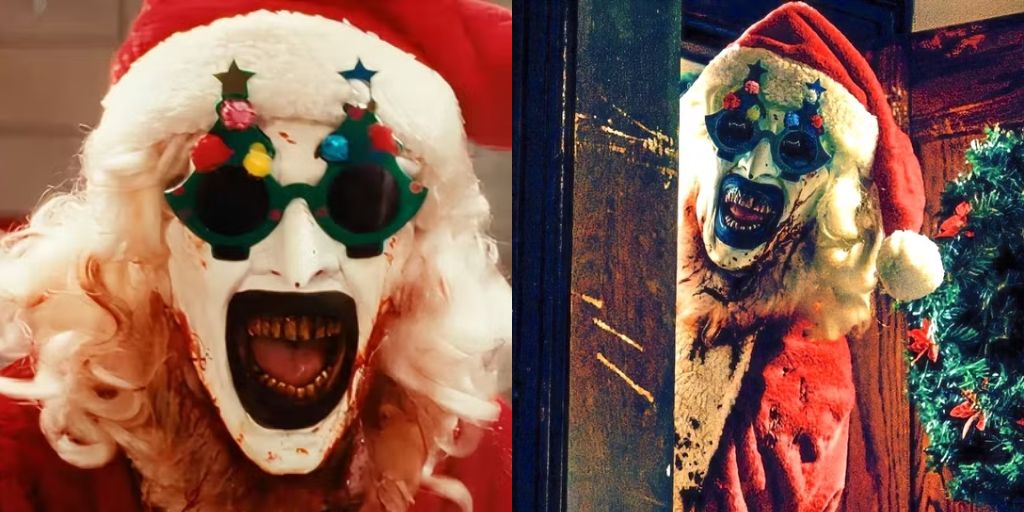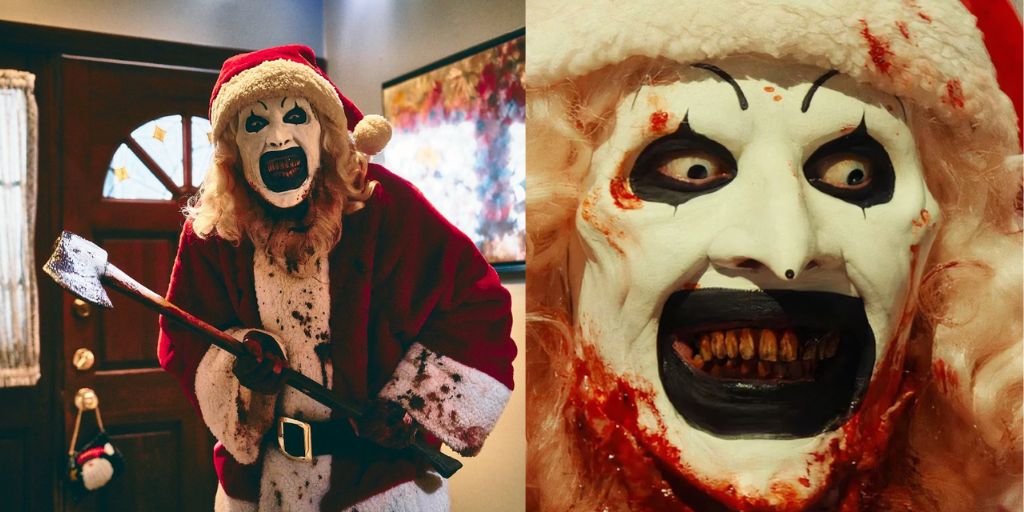The Terrifier franchise has carved its place in horror cinema, featuring the infamous Art the Clown, played brilliantly by David Howard Thornton. Art is a character unlike any other. He walks around with a giant sack filled with accessories, almost like a sinister version of Santa Claus.
His bag contains a range of tools, from harmless items like a bicycle horn or a child’s doll to terrifying instruments capable of inflicting horrific pain. This collection represents endless possibilities, blending lightheartedness and gruesome violence. The same can be said about the films in this series, especially the latest Christmas-themed installment, Terrifier 3.
Throughout this cult horror franchise, which has gained immense popularity in recent years, the storyline follows a consistent pattern. Art the Clown engages in despicable and disgusting acts of murder, showcasing his unique methods.
This brutal violence is often juxtaposed against a mundane story about ordinary people who must eventually confront Art’s terrifying presence. While the budget for Terrifier 3 has increased significantly compared to the first film, the kills have become more gruesome. Still, this latest installment remains a mixed bag, much like its predecessors.
What Is ‘Terrifier 3’ About?
For those who are new to the Terrifier series, this third film begins by immersing the audience in its distinctive brand of violence and gore. It opens with Art the Clown, dressed as Santa, entering the home of an unsuspecting family during the holiday season.
As he steps inside, the viewer quickly realizes his intentions are far from friendly. He decides to murder everyone in the house. This family exists solely to serve as fodder for Art’s chaotic mayhem.
What sets Terrifier apart from other horror franchises is its unapologetic celebration of savagery. We don’t just see Art kill the parents and their child; we witness him hack away until all that remains is a pool of red goo where humans used to be.
This bloodshed is soundtracked by the heart-wrenching screams of the victims’ loved ones. It is intense and shocking, and even those who are desensitized by the first two films in this series will find plenty to make them flinch and squirm in this latest massacre.
Terrifier 3 is set five years after the events of Terrifier 2. In the previous film, Sienna Shaw (played by Lauren LaVera) and her brother Jonathan (Elliot Fullam) survived Art’s attack. They managed to decapitate him and escape to safety. However, the act of decapitation does not mean much to Art.
At the end of Terrifier 2, viewers see his alive yet severed head being birthed by his partner-in-crime, Victoria “Vicky” Heyes (Samantha Scaffidi), in a mental institution. This shocking revelation sets the tone for the chaos that follows.
Over the last five years, Sienna has been in and out of psychiatric hospitals, grappling with her understandable fears and suffering from visions of those she feels responsible for leading to their deaths at Art’s hands. Meanwhile, Jonathan is in college, trying his best to move beyond the traumatic events of the past. This has meant staying mostly away from his sister, trying to heal on his own.
Art and Vicky, however, have been biding their time. They are literally sitting in one place, covered in dust and cobwebs, waiting for their maniacal return. While there does not seem to be a clear method to their madness, director Damien Leone expands the lore within this series in a somewhat blunt manner.
Through heavy-handed Christian imagery, it becomes evident that while Art and Vicky represent extreme evil, Sienna symbolizes the good that can counterbalance them. She may be the only one capable of stopping this twisted duo.
‘Terrifier 3’s Dual Story Is Uneven and Doesn’t Work as It Should
Terrifier 3 wants viewers to revel in the vicious kills that Art engages in, presenting new unsettling methods of destruction. Like the earlier films, Art and Leone are at their peak in showcasing bloodshed. They excel in breaking bones, peeling back skin, and allowing violence to flow.
There is no question that Leone’s skill in escalating these murders has significantly improved since the first film, and the practical effects are undeniably impressive with each new death.
However, it is the manner in which these kills are executed that makes Terrifier 3 truly horrifying. Art does not simply kill his victims; he feels the need to utterly obliterate their bodies, resulting in murders that stretch on for several agonizing minutes. Each possible part of a human is broken to cause immense pain and suffering.
What is even more disturbing is that Leone often makes family members of the deceased watch as Art wreaks havoc on their loved ones. In the opening sequence, we hear a child’s murder, followed by a mother discovering her dismembered child in his bed, crying and screaming in despair.
The Terrifier series goes so far that as viewers witness yet another person being hacked to bits, one begins to wonder if there is a larger commentary in Leone’s madness.
These films shine brightest when they focus on Thornton’s performance, particularly when he plays around with his future victims, miming jokes, and, of course, embodying the role of a clown. Art the Clown is a fascinating character who deserves more than what this franchise provides.
Art often reminds us of horror icons from the ‘80s and ‘90s who became larger than their respective franchises, like Freddy, Jason, or Pinhead. With his extreme murders and grotesque antics, Art shifts from a comical presence to a terrifying figure.
It is as if Leone is forcing viewers to question why they are drawn to movie serial killers and their fondness for violence. Alternatively, and more likely, Terrifier 3 and the franchise as a whole just wants to indulge in the maximum amount of grisly scenes without worrying about any larger meaning or message.

Yet, the duality of Terrifier 3’s story—a recurring problem throughout the series—does not work well, leading to films that feel tonally uneven. When the film relies on Thornton’s monstrous clown persona, it is silent, disturbing, and grotesque (in a good way).
But when Leone attempts to write real human characters, they often come across as stiff, unsatisfying, and frankly, boring. It feels as though these human characters exist solely to become dead bodies, and writing genuine people has never been a strong suit in this series.
This division in the story pulls the audience in two opposing directions. On one hand, Terrifier 3 clearly wants viewers to appreciate the new ways in which Leone and Art find to kill people. On the other hand, it also seeks to evoke sympathy for those who have witnessed this madness and escaped Art’s clutches.
The film wants its blood-soaked cake and to eat it too, and it fails to achieve this balance. While it is commendable that Terrifier 3 pushes the lore surrounding Art and Sienna into an interesting direction, it does so primarily for the sake of future releases, rather than offering a satisfying conclusion to this film.
The Mix of Humor and Horror
Terrifier 3 is an unusual film in an unusual series. Leone clearly wants viewers to appreciate the escalated gore present in this horrific world, but he also wants us to recognize the implications of such violence. We are invited to sit back and enjoy the organs and blood that spew everywhere.
Still, we are also told not to pay too much attention to the parents or children of the murdered who witness their lives being destroyed before their very eyes. Yet, we are expected to care when it serves the story at hand.
As a display of mindless killing, Terrifier 3 is impressive. The film showcases the practical effects and the artistry that goes into creating these horrific sequences. However, it also attempts to be more than just a collection of brutal scenes, and that is where the issues lie.
Like Art’s bag of tricks, Terrifier 3 often feels like a haphazard mix of elements drawn upon depending on the whims of its creator. It presents a chaotic blend of horror and humor that lacks a clear purpose, resulting in a film that feels disconnected at times.
The humor woven into the horror is another aspect that deserves attention. Art’s antics and clownish behavior create moments of dark comedy amidst the chaos. The juxtaposition of laughter and horror is a signature element of the franchise.
However, this balance is delicate, and it can easily tip into awkward territory. While Art’s humor can offer a brief respite from the violence, it can also undermine the film’s more serious moments. The shift from lightheartedness to brutality can leave viewers feeling confused about how to react.
The Importance of Practical Effects
One undeniable strength of Terrifier 3 lies in its practical effects. The filmmakers have poured significant resources into ensuring that each kill looks realistic and horrific.
The attention to detail in the special effects is commendable. From blood sprays to dismembered limbs, every aspect is crafted with care, contributing to the full impact of the film.

Practical effects hold a unique charm that computer-generated imagery (CGI) often fails to replicate. In a world where many horror films rely on digital effects, the Terrifier franchise stands out by embracing the visceral nature of practical effects.
The authenticity of these effects amplifies the shock value, making the horrific moments more impactful. The filmmakers have succeeded in creating a sense of realism that draws the audience into the chaos.
Character Dynamics and Development
While the practical effects in Terrifier 3 shine, the character dynamics leave much to be desired. Art the Clown is a memorable figure, and David Howard Thornton’s performance is commendable.
He brings a unique charm to the role, blending humor and horror in a way that keeps viewers engaged. However, the film’s human characters struggle to make a lasting impression.
Sienna Shaw and Jonathan, despite their traumatic backstory, often feel like placeholders rather than fully developed characters. Their experiences and struggles could be shown more deeply, providing a more satisfying emotional arc.
Sienna’s battles with her mental health and visions of the past could serve as a powerful backdrop against the chaos unleashed by Art. Unfortunately, these themes often take a back seat to the gore, leaving viewers yearning for more depth and connection to the characters.
The relationship between Sienna and Jonathan is another aspect that feels underdeveloped. They share a traumatic history, yet their interactions lack emotional weight.
The tension of surviving a horrific encounter with Art could lead to significant character growth. However, their relationship remains stagnant, primarily serving the plot rather than offering genuine character development.
The Question of Genre Expectations
As Terrifier 3 pushes the boundaries of horror, it raises questions about genre expectations. The film revels in gore, often prioritizing shock value over narrative cohesion. This approach may satisfy some fans of extreme horror, but it risks alienating others who seek a more well-rounded experience.
Horror films often show deeper themes, using fear as a lens to examine human experiences. While Terrifier 3 indulges in excessive violence, it does not fully capitalize on the potential for commentary.
The duality of its narrative—between the gruesome killings and the psychological impact on survivors—could have been a fertile ground for scheme. Instead, the film often veers into mindless brutality, sacrificing emotional depth for shock.
The franchise’s commitment to over-the-top violence can also lead to desensitization. What was once shocking may become mundane as the series progresses.
While fans may appreciate the escalating gore, there is a risk that the novelty will wear off, leaving viewers craving more than just spectacle. A successful horror film balances fear, character development, and thematic depth, creating a lasting impact that goes beyond mere shock.
The Role of Humor in Horror
Another layer to consider is the role of humor in Terrifier 3. The balance between horror and comedy is a delicate one, and the film attempts to blend these elements through Art’s clownish persona. While this can lead to moments of dark comedy, it can also create a jarring experience for the audience.
Art’s antics, from exaggerated facial expressions to playful gestures, inject moments of levity amidst the chaos. However, this humor can sometimes undermine the gravity of the situations he creates.
The juxtaposition of laughter and horror can provoke a visceral reaction, yet it can also leave viewers uncertain about how to feel. In a franchise that thrives on the extreme, the integration of humor adds complexity but also risks diluting the impact of the horror.
Setting Up for Future Installments
Terrifier 3 sets the stage for future installments in the franchise, hinting at potential developments in the lore surrounding Art and Sienna. The conclusion leaves several unanswered questions, teasing the possibility of further scenes in subsequent films. However, while these hints may excite dedicated fans, they also raise concerns about the series’ trajectory.
The film’s reliance on gore and violence may overshadow its narrative. While expanding the lore can be enticing, it is crucial to ensure that the storytelling remains cohesive and satisfying.

As audiences become accustomed to extreme horror, there is a risk that the franchise could fall into a formulaic trap, relying on shock value without meaningful character development or thematic scenes.
Final Thoughts
Terrifier 3 is an interesting addition to the franchise, showcasing impressive practical effects and a commitment to extreme horror. Art the Clown remains a attractive figure, and David Howard Thornton delivers a performance that balances horror and humor. However, the film struggles with character development and narrative cohesion, often prioritizing shock over emotional depth.
The duality of its story presents an opportunity for scenes, but it frequently falls short, leading to a tonally uneven experience. While the film may satisfy fans of gore, it risks alienating those seeking a more balanced horror experience.
As the franchise moves forward, it will be essential to find a way to integrate character arcs and thematic depth alongside the brutal killings that have become its hallmark.
Terrifier 3 ultimately serves as a reflection of the challenges faced by horror films today. It invites viewers to engage with the spectacle of violence while hinting at deeper themes, yet it often misses the mark.
The franchise has the potential to push boundaries and show new territory, but it must strive for a balance that keeps audiences engaged and invested. The legacy of Art the Clown is only just beginning, and the path forward will determine whether he becomes an enduring icon or simply another fleeting horror trend.





